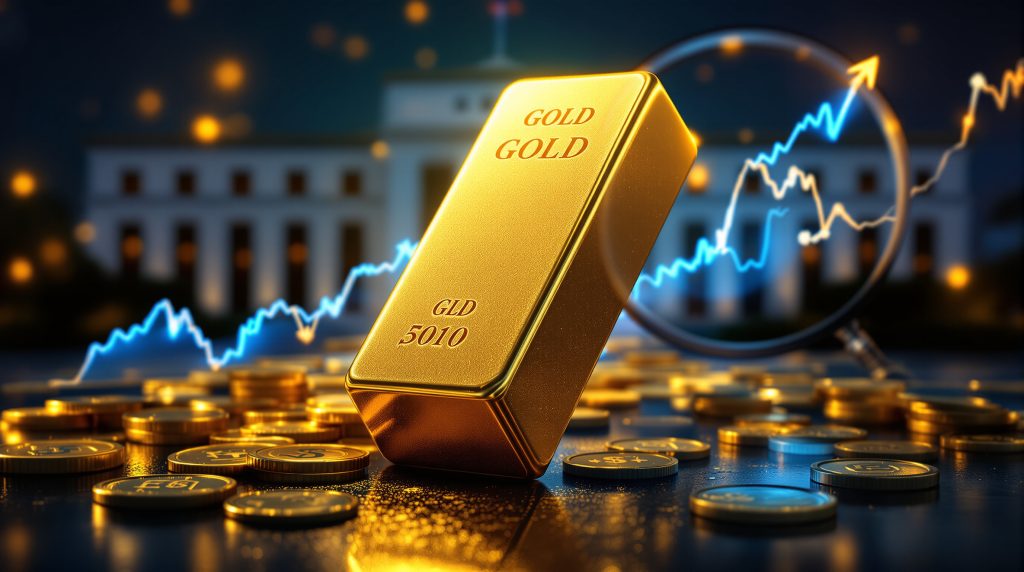Understanding How US Interest Rates Impact Gold Prices: A Comprehensive Analysis
Gold investors closely monitor US interest rate policies, recognizing them as fundamental drivers of precious metals performance. This intricate relationship forms the cornerstone of many investment strategies, yet its dynamics can shift based on multiple economic factors. This analysis examines the multifaceted connection between Federal Reserve decisions and gold market trends, offering insights for both seasoned and novice investors.
What Drives the Relationship Between US Interest Rates and Gold Prices?
The Fundamental Inverse Relationship
Gold typically moves in the opposite direction of interest rates, creating what market analysts call a negative correlation. This pattern emerges primarily because gold produces no yield or dividend, making it less attractive when interest-bearing assets offer higher returns.
Recent market data illustrates this relationship – when gold reached near $2,800 in September 2023, it coincided with expectations of Federal Reserve rate cuts. However, this relationship isn't perfectly linear. Historical analysis shows correlation coefficients between gold and interest rates fluctuating between -0.3 and -0.8 over different economic cycles.
The relationship has evolved significantly since the 2008 financial crisis. During periods of quantitative easing, gold prices surged despite near-zero interest rates, demonstrating that monetary policy's overall direction can sometimes outweigh the specific rate level.
The Opportunity Cost Mechanism
Higher interest rates increase the opportunity cost of holding non-yielding assets like gold. When the Federal Reserve maintains elevated rates, as noted by Bloomberg Intelligence analysts, dollar-denominated assets become relatively more attractive to global investors.
This opportunity cost mechanism manifests in real-world investment decisions:
- A 10-year Treasury yielding 4% provides direct income that gold cannot match
- Dividend stocks offering 2-3% annual payouts plus potential appreciation compete for the same investment dollars
- Corporate bonds with varying risk profiles create additional alternatives
Interest rate differentials between countries also significantly impact gold's global demand. When US rates substantially exceed those in Europe or Japan, international capital tends to flow toward dollar assets, potentially reducing gold demand. Conversely, when these differentials narrow, gold as an inflation hedge often benefits from increased diversification interest.
How Do Federal Reserve Policy Decisions Affect Gold Markets?
The Anatomy of Rate Decision Impact
Federal Reserve policy announcements create distinctive patterns in gold price movements. Research tracking intraday gold futures prices reveals that volatility typically increases in the 30 minutes following Federal Open Market Committee (FOMC) statements.
The market's reaction depends heavily on whether rate changes match expectations:
- Expected rate changes: Gold often shows muted reactions as markets already priced in the decision
- Unexpected rate moves: Gold can experience sharp volatility as investors rapidly reposition
The 2022-2023 rate hiking cycle demonstrated gold's resilience during aggressive tightening. Despite the Federal Reserve raising rates at the fastest pace in decades, gold maintained relatively strong performance, defying traditional expectations. This resilience partly reflected persistent inflation concerns and geopolitical tensions that supported safe-haven demand despite rate headwinds.
Forward Guidance and Market Sentiment
Federal Reserve communications extend far beyond actual rate decisions. The central bank's forward guidance – hints about future policy direction – profoundly influences gold investor sentiment and positioning.
Market participants meticulously analyze Federal Reserve statements for subtle language changes. Terms like "patient," "accommodative," or "appropriate" serve as signals for potential policy shifts. Bloomberg Intelligence analysts noted that in September 2023, forward rates showed Fed funds expected at 3.2% in one year, revised upward from an initial 3% projection, reflecting stronger-than-expected economic data.
The Fed's quarterly "dot plot" projections, which display committee members' rate expectations, serve as crucial indicators for gold traders. Divergence between market expectations and the dot plot often triggers significant price adjustments as investors recalibrate positions.
When Do Gold Prices Decouple from Interest Rate Movements?
Geopolitical Risk Factors
Geopolitical tensions frequently cause gold to break its normal relationship with interest rates. During periods of international conflict, political instability, or regional tensions, investors often prioritize safety over yield, driving gold higher regardless of interest rate environments.
Notable examples of this decoupling include:
- The 2022 Russia-Ukraine conflict, which propelled gold higher despite Fed tightening signals
- Middle East tensions in 2023-2024, creating periodic safe-haven rallies
- Trade disputes and currency devaluations, which historically increased gold's appeal
The magnitude of geopolitical premium in gold prices varies significantly based on the nature and perceived severity of global risks. Regional conflicts typically add a $20-50 premium, while major international crises can contribute $100-200 per ounce to gold prices according to historical patterns.
Inflation Dynamics and Real Rates
Perhaps the most critical factor determining gold's relationship with interest rates is the distinction between nominal and real interest rates. Real rates – nominal rates minus inflation – provide a more accurate gauge of gold's opportunity cost.
During periods of negative real rates (when inflation exceeds nominal interest rates), gold typically performs strongly despite the absolute level of nominal rates. This explains why gold reached all-time high gold analysis in environments with both low nominal rates (2020) and relatively high nominal rates (2023-2024) – the common factor was negative real rates.
Key inflation metrics gold investors monitor include:
- Consumer Price Index (CPI) and its components
- Personal Consumption Expenditures (PCE) index, the Fed's preferred inflation measure
- Break-even inflation rates derived from Treasury Inflation-Protected Securities (TIPS)
- Commodity input prices and supply chain indicators
What Historical Patterns Reveal About Rate Cuts and Gold Performance?
Gold's Response to Easing Cycles
Historical analysis of the last five major Fed easing cycles reveals consistent patterns in gold's performance. During these periods, gold has averaged approximately 15% returns in the 12 months following the initial rate cut, though with substantial variation depending on economic conditions.
Gold typically begins anticipating rate cuts 3-6 months before the first actual reduction. This "front-running" behavior reflects investors positioning for the changing monetary landscape. By the time cuts actually begin, much of gold's initial reaction may already be priced in.
The duration of easing cycles significantly influences gold's trajectory. Brief, shallow cutting cycles tend to produce modest gold rallies, while prolonged easing periods historically coincide with major bull markets in precious metals. The sustained easing environment from 2008-2011 contributed to gold's rise from approximately $700 to nearly $1,900 per ounce.
The Post-Cut Performance Window
Statistical analysis reveals distinctive performance patterns following initial rate cuts:
- First 3 months: Gold averages 4-6% gains, often with heightened volatility
- 6-month window: Returns average 8-10%, with reduced volatility
- 12-month period: Historical returns average 12-15%, though with wide variation
Market sector rotation during easing cycles follows predictable patterns that impact gold and related assets. Fixed income typically responds first, followed by precious metals and defensive equities. Mining stocks often lag physical gold initially but may outperform in the later stages of easing as operational leverage amplifies margins.
Compared to other safe-haven assets, gold has historically outperformed US Treasuries during the first 6-12 months of easing cycles but may underperform selected defensive equity sectors if economic growth remains positive. This relationship helps investors time their entry and exit points in gold positions.
How Do Central Bank Gold Purchases Interact with Interest Rate Environments?
Strategic Reserve Diversification
Central banks have become net buyers of gold since 2010, a trend that accelerated during periods of interest rate volatility. This institutional demand provides significant support for gold prices, especially during rate transition periods.
Central bank acquisition patterns show marked differences during various interest rate regimes:
- During hiking cycles: Purchases often slow but remain positive as diversification needs persist
- During cutting cycles: Buying typically accelerates, reflecting concerns about currency debasement
- During stable rate periods: Purchases usually follow long-term strategic allocation plans
Regional differences in central bank buying behavior reveal important insights about monetary policy perspectives. Eastern European, Middle Eastern, and Asian central banks have been the most consistent gold purchasers, often increasing acquisitions during periods of US monetary policy uncertainty.
De-Dollarization Efforts and Gold Demand
The relationship between dollar strength, interest rates, and central bank diversification has become increasingly pronounced. Higher US interest rates typically strengthen the dollar, which can reduce gold's appeal in dollar terms but simultaneously accelerate de-dollarization efforts by certain nations.
Quantitative analysis of reserve asset shifts during monetary policy changes reveals a clear pattern: central banks tend to accelerate gold purchases when facing significant currency volatility or when geopolitical tensions with the United States intensify. This relationship creates a counterbalancing force to interest rate headwinds.
Notable central bank gold purchases often occur strategically around major Federal Reserve policy pivots. For example, several central banks substantially increased gold acquisitions in 2019 and early 2022, anticipating significant Fed policy shifts. These institutional flows can temporarily overwhelm traditional interest rate correlations.
What Technical Indicators Help Predict Gold's Response to Rate Changes?
Key Price Levels and Support/Resistance Zones
Technical analysis reveals critical price thresholds that influence gold's reaction to interest rate news. As noted by Bloomberg Intelligence analysts in September 2023, gold established strong support around $2,500 after breaking out from a five-month bull flag formation, with resistance around $2,800.
Previous all-time highs function as powerful psychological barriers during rate transition periods. These price points often require multiple testing attempts before decisive breakouts occur, even when fundamentals support higher prices.
Fibonacci retracement levels derived from major gold market moves provide reliable technical frameworks for analyzing potential support and resistance during rate cycles. The 38.2% and 61.8% retracement levels frequently serve as reversal points during counter-trend moves following Fed announcements.
Volume and Positioning Analysis
Futures market positioning offers valuable insights into gold's potential sensitivity to rate changes. The Commitment of Traders report published by the Commodity Futures Trading Commission reveals how commercial hedgers, institutional investors, and speculators are positioned ahead of Federal Reserve decisions.
Options market data provides additional clues about expected volatility around rate announcements. The put-call ratio and implied volatility skew often signal market expectations for gold's reaction to upcoming Fed decisions.
Institutional versus retail flow analysis reveals important divergences during interest rate transitions. Professional investors typically position ahead of rate changes, while retail flows often follow after policy shifts become apparent. This sequencing creates trading opportunities for investors who monitor both segments.
How Should Investors Position for Different Interest Rate Scenarios?
Strategic Asset Allocation Approaches
Optimal gold allocation percentages vary significantly based on interest rate outlook scenarios. Historical analysis suggests:
- Rising rate environment: 5-10% allocation, focused on tactical opportunities
- Stable rate environment: 10-15% allocation, emphasizing core holdings
- Falling rate environment: 15-20% allocation, potentially overweighting mining equities
Portfolio diversification strategies incorporating gold during rate transition periods should consider correlation changes. Gold's correlation with stocks and bonds frequently shifts during monetary policy transitions, requiring regular rebalancing to maintain desired risk characteristics.
Risk-adjusted return analysis shows gold typically improves portfolio efficiency during periods of monetary policy uncertainty. The Sharpe ratio (return per unit of risk) of portfolios with gold allocations has historically increased during the first 12-18 months of easing cycles compared to those without precious metals exposure.
Gold Investment Vehicles Comparison
Different gold investment vehicles show varying performance characteristics during interest rate changes:
- Physical gold: Most stable, typically rises 1-3% immediately following unexpected rate cuts
- Gold ETFs: Similar to physical but with slightly higher volatility due to institutional flows
- Senior mining stocks: Higher volatility (2-4x gold's movement) with delayed reaction to rate shifts
- Junior miners/explorers: Highest volatility (3-7x gold) with strongest performance in established easing cycles
Liquidity considerations become particularly important during volatile rate environments. Physical gold typically experiences widened dealer spreads during market stress, while ETFs maintain tighter trading ranges. Mining equities can see dramatically reduced liquidity during market dislocations following unexpected rate decisions.
Tax efficiency analysis reveals important differences among gold investment approaches relative to interest rate cycles. Physical gold and certain ETFs are taxed as collectibles (maximum 28% rate) regardless of holding period, while mining stocks follow standard capital gains treatment. This distinction impacts after-tax returns, particularly during rate-driven bull markets.
What Are Expert Forecasts for Gold Given Current Interest Rate Projections?
Consensus Outlook Analysis
Leading financial institutions maintain varied forecasts for gold based on interest rate expectations. While specific price targets differ, most analysts anticipate continued strength in precious metals during the next phase of monetary easing.
A Bloomberg Intelligence analyst suggested a potential target of $3,000 per ounce in September 2023, noting that gold might be "front-running a potential deflationary force" from possible stock market weakness. This perspective highlights gold's role as both an inflation hedge and a portfolio stabilizer during market transitions.
Areas of disagreement among strategists center on timing rather than direction. While consensus supports higher gold prices in an easing environment, market strategists differ on how quickly rate cuts will materialize and whether gold's advance will be steady or volatile.
Alternative Scenarios and Stress Tests
Gold price forecast varies significantly under different Fed policy pivot scenarios:
- Gradual, anticipated easing: Steady appreciation with limited volatility
- Accelerated easing due to economic weakness: Potential sharp rallies with higher volatility
- Delayed easing due to persistent inflation: Consolidation periods followed by stronger eventual moves
The impact of unexpected economic data on both rates and gold creates complex market dynamics. Strong employment or growth data that delays rate cuts typically produces short-term gold weakness but may ultimately strengthen the case for higher prices if it suggests an overheating economy.
Potential black swan events could simultaneously affect monetary policy and gold prices. These include sovereign debt crises, banking system stress, or geopolitical shocks that force central banks to quickly adjust policy trajectories. Such scenarios often produce initial gold selling followed by substantial rallies as policy implications become clear.
FAQ: Common Questions About Interest Rates and Gold
How quickly does gold typically respond to interest rate changes?
Gold's response to interest rate changes follows a relatively consistent pattern. Initial market reactions occur within minutes of Fed announcements, with prices typically moving 0.5-1.5% based on the statement's perceived hawkishness or dovishness.
Secondary reactions develop over 24-48 hours as investors analyze the complete implications of policy changes. These movements often reverse initial reactions as market participants assess forward guidance and economic projections.
Longer-term trends typically take 4-6 weeks to establish following significant rate decisions. This delayed response reflects institutional portfolio adjustments and the integration of rate decisions with other economic variables.
Does gold perform differently during gradual vs. rapid rate changes?
Gold's behavior varies significantly based on the pace of rate adjustments. Gradual, telegraphed rate changes typically produce modest, predictable gold movements with lower volatility. In contrast, rapid or unexpected rate shifts create sharper price swings and potential trend changes.
Volatility metrics confirm this pattern – gold's 30-day realized volatility averages 12-15% during gradual rate adjustment periods but can spike to 20-25% during rapid policy shifts. This distinction significantly impacts option pricing and risk management strategies.
Market adaptation to different rate change velocities also affects gold pricing. During the 2004-2006 gradual hiking cycle, gold maintained an uptrend despite rising rates. Conversely, during the rapid 2022 hiking cycle, gold initially declined sharply before stabilizing and eventually advancing.
How do other factors modify gold's relationship with interest rates?
Currency movements substantially influence the rate-gold relationship. Dollar strength often amplifies the impact of rising rates on gold, while dollar weakness can neutralize or reverse expected gold declines during hiking cycles.
Equity market performance significantly modifies gold's interest rate sensitivity. When stocks decline during rate hikes (as in early 2022), gold's typical negative response to higher rates may be muted or reversed as portfolio hedging demand increases.
Global economic growth considerations frequently override simple interest rate effects. Strong global growth coupled with moderate inflation can support gold investment insights despite rising rates, while recessionary environments typically boost gold regardless of rate levels due to increased economic uncertainty.
Future Outlook: Gold's Prospects in Evolving Monetary Landscapes
The Impact of Quantitative Tightening and Balance Sheet Policies
Central bank balance sheet adjustments often exert more significant influence on gold than headline interest rates. The Federal Reserve's quantitative tightening program, which reduces its bond holdings, affects market liquidity and risk premiums in ways that can counteract or amplify the impact of rate decisions.
Historical precedents demonstrate gold's complex relationship with balance sheet normalization. During the 2017-2019 quantitative tightening period, gold initially declined but eventually stabilized and advanced as markets adjusted to reduced liquidity conditions.
The relationship between overall liquidity conditions and gold market dynamics has strengthened in the post-2008 financial landscape. Broad money supply metrics now correlate more closely with gold prices than interest rates alone, suggesting investors should monitor multiple Fed policy tools when forecasting precious metals performance.
Long-term Structural Changes in Gold-Rate Dynamics
The correlation between gold and interest rates has evolved significantly over multi-decade periods. During the 1970s and early 1980s, gold and interest rates occasionally moved in the same direction as inflation expectations dominated both markets. In contrast, the 1990s and early 2000s saw a more consistently negative relationship as real rates became the dominant factor.
Financial innovation and market structure changes continue to alter traditional relationships. The growth of gold ETFs, expanded derivatives markets, and increased institutional participation have all modified how gold responds to interest rate signals.
The potential impact of digital assets and central bank digital currencies (CBDCs) on gold's monetary role and rate sensitivity remains an emerging consideration. While cryptocurrencies have sometimes competed with gold during certain market phases, they have not fundamentally altered gold's relationship with monetary policy – both assets often respond positively to expansionary conditions and negatively to tightening cycles, though with different volatility profiles.
As monetary policy frameworks continue evolving, gold's enduring appeal as a portfolio diversifier and inflation hedge suggests it will maintain its relevance across varied interest rate environments, though investors must adapt strategies to changing correlations and market dynamics.
Ready to Stay Ahead of Major Mineral Discoveries?
Discover why major mineral discoveries can lead to exceptional market returns by exploring Discovery Alert's dedicated discoveries page, where their proprietary Discovery IQ model helps investors identify actionable opportunities before the broader market. Begin your 30-day free trial today to position yourself for the next significant ASX mining discovery.




